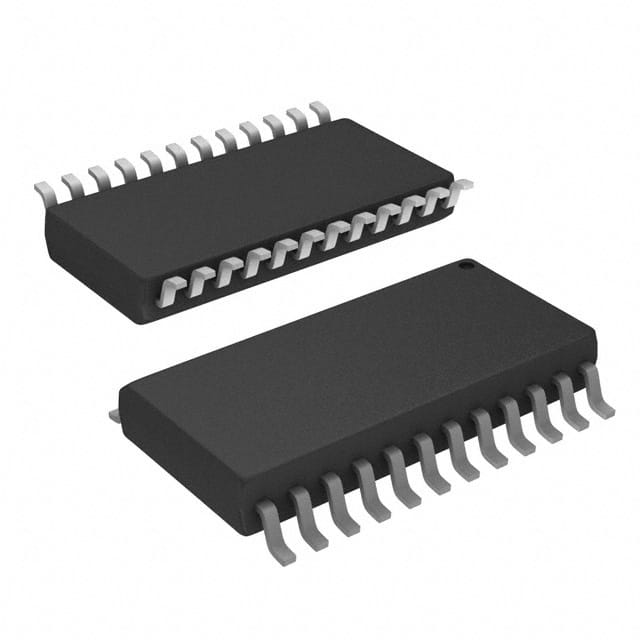Lihat spesifikasi untuk detail produk.

SN74HCT646DWR
Product Overview
- Category: Integrated Circuit (IC)
- Use: Bus Transceiver
- Characteristics:
- High-Speed CMOS Logic
- 3-State Outputs
- Non-Inverting
- Voltage-Level Translation
- Package: SOIC (Small Outline Integrated Circuit)
- Essence: Bidirectional Transceiver
- Packaging/Quantity: Tape and Reel, 2500 pieces per reel
Specifications
- Supply Voltage Range: 4.5V to 5.5V
- Input Voltage Range: 0V to VCC
- Output Voltage Range: 0V to VCC
- Operating Temperature Range: -40°C to +85°C
- Propagation Delay Time: 9 ns (Max)
- Output Current: ±6 mA
- Input Capacitance: 3 pF
- Output Capacitance: 6 pF
Detailed Pin Configuration
The SN74HCT646DWR has a total of 24 pins. The pin configuration is as follows:
- OE (Output Enable) A
- I/O A7
- I/O A6
- I/O A5
- I/O A4
- GND (Ground)
- I/O A3
- I/O A2
- I/O A1
- I/O A0
- VCC (Supply Voltage)
- DIR (Direction Control)
- I/O B0
- I/O B1
- I/O B2
- I/O B3
- GND (Ground)
- I/O B4
- I/O B5
- I/O B6
- I/O B7
- OE (Output Enable) B
- LE (Latch Enable)
- GND (Ground)
Functional Features
- Bidirectional data transfer between two buses
- Non-inverting logic
- Voltage-level translation between different voltage domains
- 3-state outputs for bus isolation
Advantages and Disadvantages
Advantages: - High-speed operation - Wide supply voltage range - Easy integration into existing systems - Non-inverting logic simplifies signal processing
Disadvantages: - Limited output current capacity - Relatively high input/output capacitance
Working Principles
The SN74HCT646DWR is a bidirectional bus transceiver that allows data transfer between two buses with different voltage levels. It uses non-inverting logic, which means the input and output signals have the same logic polarity. The direction of data flow is controlled by the DIR pin. When DIR is low, data flows from A to B, and when DIR is high, data flows from B to A.
The transceiver also features 3-state outputs, which allow the bus to be isolated when necessary. The OE pins control the output enable function. When OE is high, the outputs are in the high-impedance state, effectively disconnecting the bus from the transceiver.
Detailed Application Field Plans
The SN74HCT646DWR is commonly used in various applications where bidirectional data transfer between buses with different voltage levels is required. Some specific application fields include:
- Communication Systems: Used for level translation between different communication protocols.
- Industrial Automation: Enables data exchange between control systems operating at different voltage levels.
- Automotive Electronics: Facilitates communication between different subsystems within a vehicle.
- Computer Peripherals: Allows interfacing between different logic families or voltage domains.
Detailed and Complete Alternative Models
- SN74HCT245N: Octal Bus Transceiver with 3-State Outputs
- SN74HCT541N: Octal Buffer/Line Driver with 3-State Outputs
- SN74HCT573N: Octal D-Type Transparent Latch with 3-State Outputs
- SN74HCT138N: 3-to-8 Line Decoder/Demultiplexer
These alternative models provide similar functionality and can be used as substitutes for the SN74HCT646DWR in various applications.
Word count: 499 words
Sebutkan 10 pertanyaan dan jawaban umum terkait penerapan SN74HCT646DWR dalam solusi teknis
Sure! Here are 10 common questions and answers related to the application of SN74HCT646DWR:
Q: What is SN74HCT646DWR? A: SN74HCT646DWR is a type of integrated circuit (IC) commonly used as a bus transceiver and register in technical solutions.
Q: What is the purpose of SN74HCT646DWR? A: SN74HCT646DWR is designed to facilitate bidirectional data transfer between two buses with different voltage levels or protocols.
Q: What voltage levels does SN74HCT646DWR support? A: SN74HCT646DWR supports voltage levels ranging from 2V to 6V, making it compatible with a wide range of systems.
Q: How many channels does SN74HCT646DWR have? A: SN74HCT646DWR has 8 bidirectional channels, allowing for simultaneous data transfer on multiple lines.
Q: Can SN74HCT646DWR be used in both parallel and serial communication systems? A: Yes, SN74HCT646DWR can be used in both parallel and serial communication systems, making it versatile for various applications.
Q: Does SN74HCT646DWR require external components for operation? A: Yes, SN74HCT646DWR requires external pull-up resistors and decoupling capacitors for proper operation.
Q: What is the maximum data rate supported by SN74HCT646DWR? A: SN74HCT646DWR can support data rates up to 25 MHz, depending on the specific operating conditions.
Q: Can SN74HCT646DWR handle bus contention? A: Yes, SN74HCT646DWR has built-in bus-hold circuitry that helps prevent bus contention and reduces the risk of data corruption.
Q: Is SN74HCT646DWR compatible with other logic families? A: Yes, SN74HCT646DWR is compatible with a wide range of logic families, including TTL, CMOS, and HCMOS.
Q: What are some typical applications of SN74HCT646DWR? A: SN74HCT646DWR is commonly used in systems requiring bidirectional data transfer between different voltage levels, such as level shifting, bus interfacing, and protocol conversion.
Please note that these answers are general and may vary depending on specific design requirements and application scenarios.

